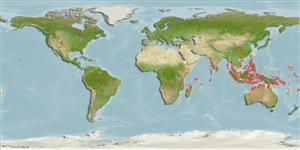>
Eupercaria/misc (Various families in series Eupercaria) >
Labridae (Wrasses) > Corinae
Etymology: Halichoeres: Greek, als, alis = salt + Greek, choiros = pig (Ref. 45335).
More on author: Bleeker.
Environment: milieu / climate zone / depth range / distribution range
Écologie
marin récifal; profondeur 5 - 15 m (Ref. 90102). Tropical
Indo-West Pacific: known at present only from Sri Lanka to Indonesia. Male Halichoeres nebulosus and Halichoeres margaritaceus have always been misidentified as Halichoeres kawarin, which may be responsible for attributing a greater range to this species.
Taille / Poids / Âge
Maturity: Lm ? range ? - ? cm
Max length : 12.0 cm TL mâle / non sexé; (Ref. 48636)
Identified by cheek and body patterns. Most similar to H. binotopsis and is best distinguished by the more angular versus horizontal cheek lines (Ref. 48636).
Found in shallow coastal reefs, mainly rock substrates with soft coral and algal growth. Occurs in small loose groups dominated by a large male (Ref. 48636). May also be found solitary (Ref. 90102).
Life cycle and mating behavior
Maturité | Reproduction | Frai | Œufs | Fécondité | Larves
Distinct pairing during breeding (Ref. 205).
Randall, J.E., 1980. Two new Indo-Pacific labrid fishes of the genus Halichoeres, with notes on other species of the genus. Pac. Sci. 34(4):415-432. (Ref. 2136)
Statut dans la liste rouge de l'IUCN (Ref. 130435)
Menace pour l'homme
Harmless
Utilisations par l'homme
Aquarium: Commercial
Plus d'informations
RéférencesAquacultureProfil d'aquacultureSouchesGénétiqueElectrophoresesHéritabilitéPathologiesTraitementNutrientsMass conversion
CollaborateursImagesStamps, Coins Misc.SonsCiguateraVitesseType de nageSurface branchialeOtolithesCerveauxVision
Outils
Articles particuliers
Télécharger en XML
Sources Internet
Estimates based on models
Preferred temperature (Ref.
123201): 26.6 - 29.2, mean 28.7 °C (based on 2004 cells).
Phylogenetic diversity index (Ref.
82804): PD
50 = 0.5000 [Uniqueness, from 0.5 = low to 2.0 = high].
Bayesian length-weight: a=0.00955 (0.00451 - 0.02020), b=3.09 (2.92 - 3.26), in cm total length, based on LWR estimates for this Genus-body shape (Ref.
93245).
Niveau trophique (Ref.
69278): 3.4 ±0.5 se; based on size and trophs of closest relatives
Résilience (Ref.
120179): Haut, temps minimum de doublement de population inférieur à 15 mois (Preliminary K or Fecundity.).
Fishing Vulnerability (Ref.
59153): Low vulnerability (10 of 100).
Nutrients (Ref.
124155): Calcium = 108 [64, 190] mg/100g; Iron = 0.795 [0.451, 1.497] mg/100g; Protein = 18.5 [15.6, 20.7] %; Omega3 = 0.152 [0.094, 0.248] g/100g; Selenium = 19.9 [11.4, 37.2] μg/100g; VitaminA = 153 [47, 567] μg/100g; Zinc = 1.9 [1.3, 3.0] mg/100g (wet weight);
